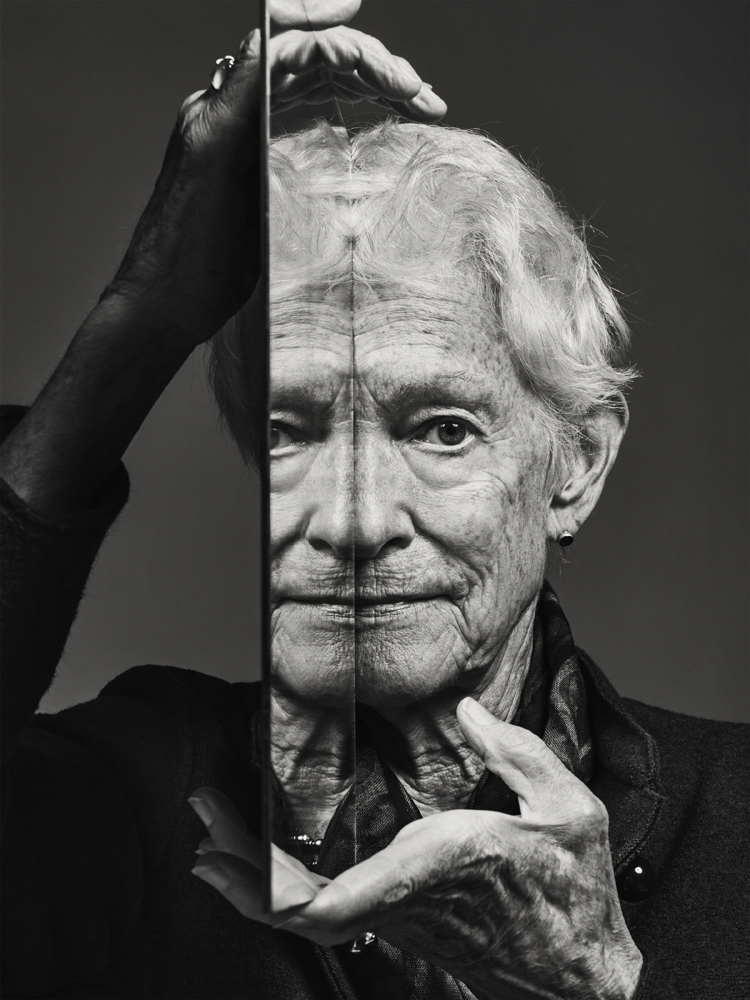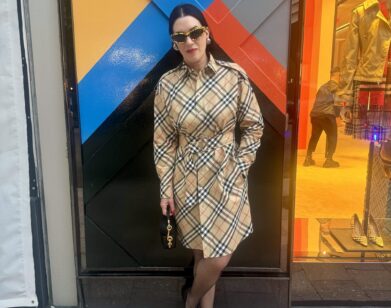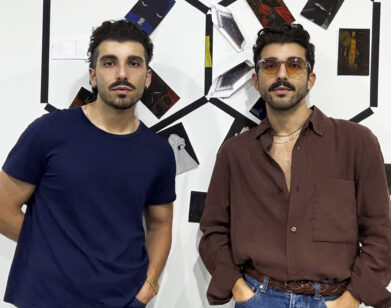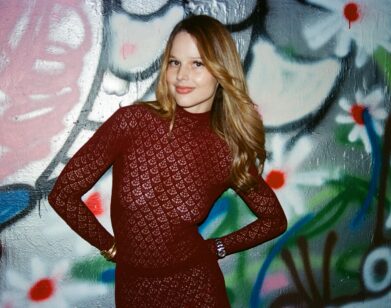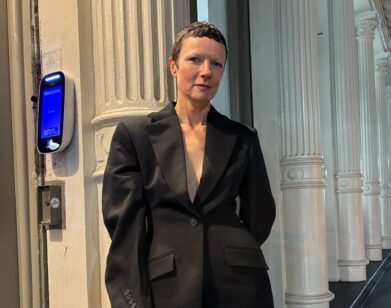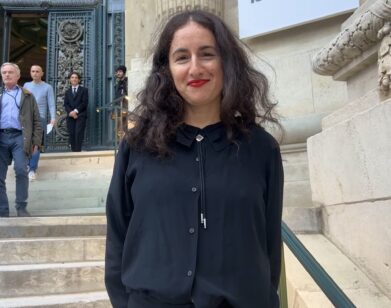Joan Jonas
I LEARNED EVERYTHING I DO IN THE STREET. BECAUSE THEY DIDN’T TEACH IT IN ART SCHOOL THEN. JOAN JONAS
I’m not exactly sure what it says about us that, when looking back at Joan Jonas’s career in performance and video—a career that found its footing in the frenetic downtown scene of New York in the mid-’60s—her work still seems shocking, fresh, provocative, and like it’s trying to tell us something we have yet to grasp some 50 years later. I don’t know if that response is due to the fact that performance-based art itself fell into near oblivion during the explosion of the object-driven art market in the 1980s and is only now getting its deserved spotlight. Or if the powerful feminist overtones in Jonas’s work—many of her early iconic pieces involved mirrors, masks, and bodily scopophilia—haven’t dissipated in a culture that still pays obsessive attention to the female form. Or, and I think most likely, when the 78-year-old artist was making her seminal pieces, she was creating something timeless and irreducibly human. Jonas says that, over her career, she has tried to develop her own language. That idiosyncratic language manages to weave in myths, spirituality, counter-histories, and marginalized people; dance, technology, literature, folklore, and ethnology; travel, natural wonders, headdresses, animal masks, and music (she’s collaborated with a number of musicians, dancers, and actors). I’m not sure if she’s more shaman or scientist, but what Jonas has managed to produce, particularly in the past decade and a half, are total worlds amid her full-surround installations—both controlled and improvised—often in which Jonas herself appears, live or projected, or both.
Just this past fall, the HangarBicocca in Milan hosted one of the most comprehensive retrospectives of Jonas’s work to date (including a version of her 2010 work Reanimation, a combination of videos, sounds, drawings, and words on four screens that visitors can walk around). And she’s currently at work on what will be her second big stage in Italy in the span of a year: In May, Jonas is representing the United States at the Venice Biennale. This past October, Jonas’s friend the painter R.H. Quaytman visited Jonas’s studio in SoHo, the neighborhood she has called home since the late ’60s, and where she can often be found walking her poodle, Ozu. Quaytman brought along her poodle, Jacob, and over playing dogs and a bottle of red wine, Jonas and Quaytman discussed performance, technology, and the good old rough days of SoHo. —Christopher Bollen
JOAN JONAS: We should talk about how we know each other. I went to art school in Boston in the late ’50s and early ’60s with your mother, the poet Susan Howe.
R.H. QUAYTMAN: And my father.
JONAS: And your father, the painter Harvey Quaytman. We were very good friends. I saw you the day you came home from the hospital.
QUAYTMAN: Mom says I was conceived in your apartment.
JONAS: [laughs] Well, yes, I remember they told me that too. I had an apartment in New York, and I think they came and stayed there.
QUAYTMAN: So I was conceived in New York maybe? And not in Boston! How did you end up studying at the Boston Museum school?
JONAS: I went to Mount Holyoke, and my sculpture teacher thought I shouldn’t go back to New York, where my family was. He thought I should get away from that context and go to Boston.
QUAYTMAN: And then you came back down to New York right after. Did you live in SoHo right away?
JONAS: No. I was married at the time to Gerry [Gerald] Jonas, and we got an apartment on East 87th Street. But then I went to school at Columbia. I went because I needed more structure to develop, and they had a one-year graduate program. The studios were in the rotunda of Low Library. It was very different from the way it is now. I moved to SoHo in 1968.
QUAYTMAN: You were making sculpture at first, right?
JONAS: Well, I tried, in my studio, in my little room in my apartment.
QUAYTMAN: I’m interested in your transition from sculpture to performance.
JONAS: It was the ’60s and I was lucky. My ex-husband, Gerry Jonas, was a good friend of Henry Geldzahler.
QUAYTMAN: My mother also knew him.
JONAS: That’s right, because Henry was in Boston too. He went to Harvard.
QUAYTMAN: Apparently my father had to pick up Edie Sedgwick from the train station when she first came down from Cambridge to New York. And then she just dropped him like a hot potato. [laughs]
JONAS: Henry had gotten a job at the Metropolitan Museum, and as he was also close friends with Gerry’s friend Calvin Trillin, who was known as Bud, he would tell Bud about events that were going on downtown, like Claes Oldenburg’s happenings and La Monte Young’s concerts. So I was very lucky for a few years in the ’60s to see a lot of things early on. I was attracted by the kind of work I was seeing, and that’s why I shifted. I wasn’t happy with my objects, my sculpture.
QUAYTMAN: What were they like?
JONAS: They were very influenced by Giacometti. I ended up destroying them all. They were not relevant. I wanted to explore new forms that were related to sculpture, and that included drawing, sound, and movement in space. Performance for that generation of artists seemed to open things up.
QUAYTMAN: It was also the dialogue of your time. Whereas sculpture maybe felt a little bit ’50s.
JONAS: Yes, exactly. I immediately saw that I could combine sound, music, and movement the minute I started taking workshops taught by a lot of the dancers. I just loved it. It wasn’t a rational decision.
QUAYTMAN: That’s what I feel like I did with painting a little bit, where I try to migrate ideas from installation art or film or something that I’m reading into painting. The ideas for me never start in paintings. I think you and I have a lot in common, in terms of the research we do and the cosmologies we build.
JONAS: Your work is among the most interesting. You treat the canvas as an object, so it has a relationship to three-dimensions. And you deal with that surface, like your diamond-dust paintings or in your use of signs and symbols. You’ve created your own visual language. I also wanted to develop my own language.
QUAYTMAN: What was the downtown performance scene like that you entered in the ’60s?
JONAS: I didn’t really enter a scene, so to speak. I saw Oldenburg’s happenings and dances by Yvonne Rainer, Deborah Hay, Simone Forti, Steve Paxton, and Trisha Brown, and also pieces by Rauschenberg. I saw this collaboration between dancers and visual artists. What attracted me was that you could be a visual artist and do something time-based. I think Oldenburg called his work performance, but there wasn’t anything like performance art yet. There was a feeling, rather, among friends. There were sculptors, painters, dancers, musicians; it was all these different people working in different mediums. So there wasn’t one, isolated scene. Everybody went to see everybody’s work, including mine.
QUAYTMAN: It was a small group.
I RELATED PERFORMANCE TO THE STRUCTURE OF FILM AND MUSIC, AND TO THE RITUALS OF OTHER CULTURES. TO ME, THERE’S ALWAYS A RELATIONSHIP. JOAN JONAS
JONAS: It really was. And then there was the Living Theatre and Squat Theatre—interesting theater groups like that. It was all below 14th Street. There was this feeling of exchange, but also there was a feeling of excitement that everybody was kind of on the edge of something. I think that’s a big difference between then and now. I’m not saying that it was better than now, but it was different because it was small. And it seemed like we were breaking ground. Also, today, young artists coming out of art school have a vast array of choices as far as genre and style. Back then it was much more focused—for instance, minimalism. Jack Smith was really on the edge. You went to his performance, and there were ten people. We’d go to midnight performances.
QUAYTMAN: Where would they be?
JONAS: In his loft on Greene Street. He had two floors and the roof had burned out from a fire, so he had a kind of double-story theater. He had a bleacher made out of two-by-fours, and there would be about six people there for a midnight performance. So it was a completely different atmosphere. Also I regularly attended Anthology Film Archives, where I saw the history of film. It was around the corner. Jonas Mekas, who was the force behind Anthology, is such an important figure.
QUAYTMAN: Where were your early performances?
JONAS: Some were in galleries or the performance space in Saint Peter’s Church. And I did things at [Jack] LoGiudice Gallery and then later at [Leo] Castelli and at Sonnabend. I also made works outdoors at Jones Beach and on the Lower West Side of Manhattan near the docks.
QUAYTMAN: What were the early outdoor pieces like?
JONAS: The first performance outdoors happened at Jones Beach [Jones Beach Piece, 1970]. It was based on the idea of how our perception of image and movement is altered by distance. A group of us performed a series of choreographed movements and signals with simple props such as a six-foot metal hoop, a ladder, a rope, a bag of shells, and a shovel. For instance, Susan Rothenberg, tied into the hoop, was rolled about by George Trakas and John Erdman. The audience was a quarter of a mile away. Performers stood at different distances from the audience and clapped blocks of wood together over their heads. The farther away, the greater the sound delay. We next performed this work on the empty lots and the docks of the Lower West Side. It was called Delay Delay [1972]. We performed similar actions signaling to each other and the audience—who was situated on what is now the roof of Richard Serra’s loft building—from the farthest ends of the docks and the edges of the lots. Carol Gooden and Gordon Matta-Clark spent the entire performance painting a big circle and a line in the street below. Their dog sat nearby watching. Cars would slowly approach, slow down, and drive by carefully. During these performances, we were never interfered with. It was a different time.
QUAYTMAN: To think about the difference between then and now, you just need to think about the landscape of the docks on the Hudson River.
JONAS: Yeah, it was so beautiful and rough. Were you near there in the ’70s?
QUAYTMAN: We lived on Christopher Street, so I was right next to it. They were so intense and beautiful.
JONAS: Yes, I was around the corner, on Charles Street. A lot of people were doing works on the docks, like Gordon Matta-Clark.
QUAYTMAN: Should we discuss what it was like for women artists at the time?
JONAS: The women’s movement was super important for all us. Your mother and I were in a women’s group. It had a big influence on all of us. But the men, our peers, were also interested in that movement and part of it. I would say it affected their lives as well. [dogs start barking in background]
QUAYTMAN: Jacob! No, no, no! Sit.
JONAS: Ozu, come here.
QUAYTMAN: They’re good guard dogs. You were talking about how the feminist movement was very important to male artists. But I think it was also important to gay male artists. That’s maybe an under-examined relationship.
JONAS: You’re absolutely right. But just as an example of the former, I remember Gordon Matta-Clark liked to wrestle. In the dance world, the bodies were always touching and rolling around. And people were really glad to join in. But I remember being under a table with some others in a restaurant and Gordon just joining in. He was really wonderful.
QUAYTMAN: You still see a lot of separation between male artists and women artists today.
JONAS: There are still all kinds of inequality.
QUAYTMAN: There’s inequality and there’s also just separation.
JONAS: Well, one of the things about performance and the area that I went into was that it wasn’t male-dominated. It wasn’t like painting and sculpture.
QUAYTMAN: It was female-dominated. Who were some of the women who inspired you?
JONAS: Yvonne Rainer, Lucinda Childs, and Simone Forti. But I was also inspired by writers and sculptors.
QUAYTMAN: And film. You were pretty much observing everything around you, right? Including music.
JONAS: Yeah. I felt that you could translate something from one form to another. I related performance to the structure of film and music, and to the rituals of other cultures. To me, there’s always a relationship. Which I imagine is the way you think of it too. Who were some of your early influences?
QUAYTMAN: Always people who were not painters. Andrea Fraser is a good example, and Dan Graham.
JONAS: Where did you meet him?
QUAYTMAN: I met him by accident at [MoMA] PS1 when I was the program coordinator there in ’89.
JONAS: Working at PS1 was a big influence on you, wasn’t it?
QUAYTMAN: Huge. That was the biggest influence. It opened up a world I hadn’t known through my family.
JONAS: It’s the same with the job I had after Columbia. This guy who went to Woodstock Country School, where I went, David Whitney, worked at the Green Gallery, and I was looking for a part-time job. I walked into the Green Gallery, and David gave me a job as a receptionist.
QUAYTMAN: That’s how I started at PS1!
JONAS: Well, it was the same thing for me. It was like all of a sudden …
QUAYTMAN: The doors opened.
JONAS: And seeing all this work. Larry Poons and Lucas Samaras showed at the Green Gallery. And there was Dick Bellamy, the charismatic poet—it was his gallery.
QUAYTMAN: You kind of stumble into an education.
JONAS: I tell people that I learned everything I do in the street. Because they didn’t teach it in art school then. Now they teach everything in art school.
QUAYTMAN: Do you see a younger generation of artists following in your footsteps in terms of nontraditional mediums?
JONAS: I see it, certainly, and I try to follow the interesting threads, but because I’m so busy working, I miss a lot. But I am really curious.
QUAYTMAN: I am too. That’s why I like to teach at Bard. I always just get my little shot of what’s happening with younger artists.
JONAS: Teaching has been important for me for similar reasons. There is a lot of work going on with new forms-in relationship to technology, for example.
QUAYTMAN: It’s kind of valueless new forms, not-for-sale forms. Forms that are totally changing everything. Although, Richard Prince has a show of Instagram screen-grabs, so they’re figuring out how to market it. What is your feeling on technology?
JONAS: I’ll say one thing about technology—you can’t separate my work from technology, because my work exists within the fabric of technology. And it’s also affected by it. So technology is inseparable from my work, and I think it’s the same for you.
QUAYTMAN: My work is definitely post-computer. I agree.
JONAS: Oil paint was a new technology when they began using it in the early Renaissance. So we’re all involved with technology in different ways. But I call myself an old-fashioned video artist. They have a program at Tate Modern called “Tate Live,” for which artists come in to compose a live performance that is immediately broadcast on the internet, on YouTube. I find that interesting. You talk directly to an audience at the moment of the performance. And then later, of course, it’s recorded and people look at it. Then it’s the same old thing. But at that live moment, it’s quite interesting. Nam June [Paik] did that a long time ago.
QUAYTMAN: Now, of course, we realize how important Nam June was.
JONAS: He was one of the first people who saw video as an art form.
QUAYTMAN: You must have known all of those people from the beginning.
JONAS: I did. Nam June lived next door to this loft. But what’s your impression of the present situation? I know that’s a huge question. That’s what they kept asking me in Italy.
QUAYTMAN: I do feel it’s a paradigm-shift time. Kind of a total eclipse of the idea of there being a future, which is pretty much gone. We had that once.
JONAS: Well, we had hope.
QUAYTMAN: We did—just even in the idea that the century would turn, that it would be 2000. But now I feel like there isn’t much hope; it’s all pretty dark. But it’s this kind of dark that hasn’t yet hit, like an it’s—coming kind of vibe. Also, just the way the internet is restructuring people’s brains. And in terms of art, it’s like how wit has changed. You always have to understand the wit of your time. That’s the hardest thing to understand, the good wit.
JONAS: That’s an interesting thing to say. Are you talking about wit as a comic wit? Comedy fascinates me.
QUAYTMAN: Yeah, you know, the thing that says, “yes, no,” at the same time. The thing that goes at the button of something.
JONAS: And what do you think that is now?
QUAYTMAN: I couldn’t name it, but I feel like I know it when I see it or when I am experiencing it in a younger artist.
JONAS: The way of looking at art has changed. It’s shifting radically, partly because of art fairs. We all used to sit in front of paintings for a long time, almost like you would sit in front a television set. You would sit and really look at it. Now people just pass by.
QUAYTMAN: I noticed that early on. I try to make paintings for strolling. [laughs] Well, not all of them, but I try to acknowledge that the audience is moving, and they’re not always in front of it. They’re at the side or passing by.
I SET THINGS UP AND EXPERIMENT OR IMPROVISE UNTIL I FIND SOMETHING. I ALWAYS COMPARE IT TO COOKING. JOAN JONAS
JONAS: That’s one of the reasons my work is hard for some people, I think, because they have to spend time with it. A lot of people don’t know my work because of that.
QUAYTMAN: I think people know your work, but you have an interesting career. People probably think of your work in the ’60s and ’70s and the work you’ve done in the last decade or so. How did the ’80s and ’90s impact your work?
JONAS: It was suddenly about money in the ’80s. And my work kind of disappeared. It’s true. Suddenly there was an interest in painting and sculpting and not so much in what I was doing. Artists go up and down and in and out of focus—I went through a period of quietude. I kept working, but I felt like I was outside of things during the ’80s.
QUAYTMAN: Was that a gradual shift, or did it feel sudden?
JONAS: It was very sudden at the beginning of the ’80s, and then in the ’90s, I really had to fight hard to feel visible again. But not in an obvious way. In a quiet way. On the other hand, I felt close to certain artists of the ’80s. There were many important and interesting artists from that time, and several are good friends. But the women artists of the ’80s represent a particular strength.
QUAYTMAN: I think the ’80s forced conceptual artists to articulate what they were doing in opposition to something that was very clear and very evident.
JONAS: Maybe. That’s interesting.
QUAYTMAN: Maybe that was a healthy thing about it. And the East Village happened. That was huge.
JONAS: Pat Hearn was in the East Village. And Colin [de Land].
QUAYTMAN: Just their presence had a huge influence: a new art history was established with a certain group of artists. And October magazine was there, and that was a big opposition. And then Douglas Crimp and the Pictures Generation and Metro Pictures and all of that—all, I would say, in opposition to neo-expressionism.
JONAS: It could be. Douglas is a very close friend of mine. I’ve known him since the ’70s, and I feel that my work overlapped with the Pictures Generation. Douglas has said that, anyway, and I see the connections.
QUAYTMAN: A number of your earlier performances have been restaged in the last few years—under your direction. How is it to revisit those pieces?
JONAS: I have different ideas about that. First of all, you can never see the original work as it was. You can never experience that again. There’s just no way you can do that. It’s a live form. Re-performing is called reenactment, although I don’t like that term. I wasn’t so interested in a reenactment or a re-performance, but the Guggenheim asked me to do a piece in 2010—one of my early mirror pieces. So I did it.
QUAYTMAN: The one with the performer examining herself in a round mirror [Mirror Check, 1970]?
JONAS: No, it was a group piece of about 17 people holding large mirrors and moving slowly in choreographed patterns [Mirror Piece I, 1969]. The audience saw themselves in the mirrors. I found redoing it very interesting, actually. The only works I’ve “re-performed” were those early mirror works at the Guggenheim and last year in Stockholm. It was hard work, and I changed some of it a little bit, because it’s a different time. But I really enjoyed it.
QUAYTMAN: Your audience is seeing these pieces with an entirely different lens.
JONAS: Of course. The context of then versus the context of now. The audience perceives it differently.
QUAYTMAN: The use of mirrors in your performances sort of proposes the idea of restaging.
JONAS: I repeat all of my performances over and over again, so it’s not like there’s a purity of one performance. While I make a work with the viewpoint of the audience in mind, I can never fully anticipate how the audience will perceive a work, because everybody brings something different to it. Of course, much has changed in 40 years. But in some ways, 40 years isn’t such a long time ago.
QUAYTMAN: No, it’s not. I don’t think art is as temporal as it appears in galleries. I mean, 40 years ago is yesterday to tomorrow. [laughs]
JONAS: When we look at art history, we look at the Renaissance, we look at the 15th century. We don’t look at, like, 1484 and 1494 as being that different. And if you look at the ’70s, the ’80s, and the ’90s, there are all kinds of overlaps and continuities.
QUAYTMAN: Right. That’s why we both love [19th-century art historian] Aby Warburg, because he tried to read art and culture through a different idea of time, something more like cosmological time.
JONAS: Cross-cultural. Tracing elements through decades and centuries.
QUAYTMAN: You have a big retrospective right now in Milan at the HangarBicocca. And of course, you are also representing the United States at the Venice Biennale in May. Have you already started working on the Biennale?
JONAS: I know the basic themes and have made some of the elements. It’s a very special opportunity, of course. I’m going to Venice for six weeks in the middle of March. I’m kind of scared and excited at the same time. I know I just have to buckle down and do it.
QUAYTMAN: Do you like the space of the American pavilion?
JONAS: It’s not about liking it or not liking it. It’s about dealing with it.
QUAYTMAN: Yes. [laughs] That’s so true. It’s kind of a funny Jeffersonian building.
JONAS: It’s four rooms with a rotunda in the middle of it. They’re not so big. Some use the words nut to crack when speaking of it, and that’s true. Of course, not everyone does new work. Bruce [Nauman] showed early work in 2009, for example. And then Fred Wilson tried to deal with the space and the location of Venice in 2003, which was quite interesting. I try to go every year because I love Venice and I love to see the work of the artists there.
QUAYTMAN: I really love Venice too, in the winter especially. It’s a completely magical place. And it’s the one place where I don’t feel guilty to be a tourist.
JONAS: Oh, you should never feel guilty. We’re all tourists.
QUAYTMAN: What work do you have in mind to show?
JONAS: I’m making a whole new piece that is developing out of my most recent work in reanimation, and I’m including work that I’ve done in the past two years that hasn’t been shown. MIT is renting me a studio just for the development of this project, which will probably spoil me.
QUAYTMAN: What do you think your representation means on this international or all-star platform?
JONAS: I think that I represent those who feel represented by me—a certain number of Americans, of women of a young generation, and of nature. And I will say that when I see a group show written about in a magazine, I always count how many women are in it.
QUAYTMAN: The Guerrilla Girls taught us that.
JONAS: There’s always less women, of course. Sometimes a lot less.
QUAYTMAN: You know what I get a lot? Museums will ask, “Why don’t you do this show with another woman artist?” Do you ever get that?
JONAS: Yeah. You do too?
QUAYTMAN: A lot. Two women artists. It’s weird that that happens so much.
JONAS: It’s not so long ago. Not at all.
QUAYTMAN: Work can be personal without being autobiographical. Would you ever describe your work as autobiographical?
JONAS: No. I am absolutely against that. You could say it’s personal, but it’s not autobiographical. Everything comes from within you. Our work comes from within us and from our experience, but autobiography is, “Oh, my father was this and my mother was this.” It’s not about that.
QUAYTMAN: Exactly. In your video work, you often compile very different visceral images. How do these images come to you? Let’s make clear, they are not fragments from your autobiography.
JONAS: It’s a combination. When I start a piece, I don’t really know exactly what it’s going to be. I set things up and experiment or improvise until I find something. I always compare it to cooking. Something chemical happens. And then you’re surprised.
QUAYTMAN: And then you have to feed somebody. [both laugh] I’m the exact same way, only I make a lot of rules to sort of rein it in. Otherwise I get so anxious about the repetition. I have a question: You’ve lived in SoHo for 46 years. How do you like it? A lot has obviously changed from burnt-out roofs on Greene Street.
JONAS: I like my loft, and to move would take too much time. It would take two years out of my life. I like SoHo at night and in the early morning. Otherwise it has become a monster. At the beginning it was raw, rough, and generative. And a little dangerous.
QUAYTMAN: Now it’s like a mall.
JONAS: It’s become a shopping center. I don’t like that. Artists have been squeezed out, and that’s not a pretty picture if you look at it that way. There are a few artists living here who have been here since the very beginning.
QUAYTMAN: But you also go to Nova Scotia in the summer.
JONAS: Yes, I have a house and a studio there. I go there in the summers and work.
QUAYTMAN: Living in New York City is like living in the subway of the world. That’s my feeling. If you want to live in a subway of the world, come to New York. [laughs] And I do, weirdly. That’s the sad thing. Because there’s no other subway stop in America.
JONAS: I like New York because my friends are here. That’s what makes it a great city for me.
R.H. QUAYTMAN IS A VISUAL ARTIST BASED IN NEW YORK.

